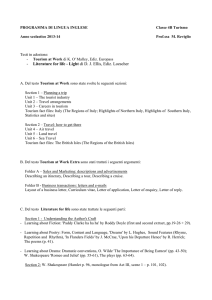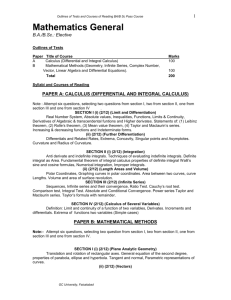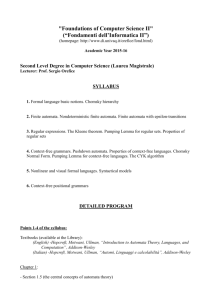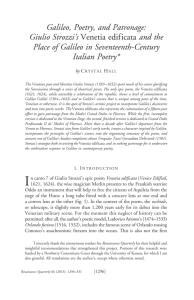The Exhibition Layout in 18 Sections
advertisement
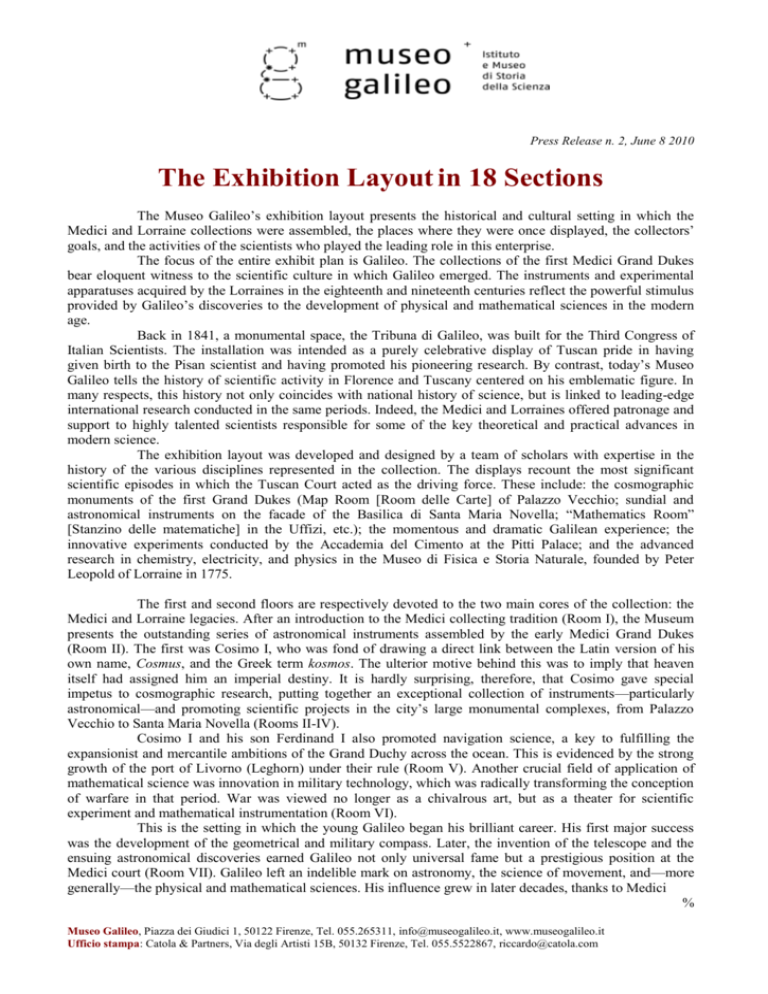
Press Release n. 2, June 8 2010 The Exhibition Layout in 18 Sections The Museo Galileo’s exhibition layout presents the historical and cultural setting in which the Medici and Lorraine collections were assembled, the places where they were once displayed, the collectors’ goals, and the activities of the scientists who played the leading role in this enterprise. The focus of the entire exhibit plan is Galileo. The collections of the first Medici Grand Dukes bear eloquent witness to the scientific culture in which Galileo emerged. The instruments and experimental apparatuses acquired by the Lorraines in the eighteenth and nineteenth centuries reflect the powerful stimulus provided by Galileo’s discoveries to the development of physical and mathematical sciences in the modern age. Back in 1841, a monumental space, the Tribuna di Galileo, was built for the Third Congress of Italian Scientists. The installation was intended as a purely celebrative display of Tuscan pride in having given birth to the Pisan scientist and having promoted his pioneering research. By contrast, today’s Museo Galileo tells the history of scientific activity in Florence and Tuscany centered on his emblematic figure. In many respects, this history not only coincides with national history of science, but is linked to leading-edge international research conducted in the same periods. Indeed, the Medici and Lorraines offered patronage and support to highly talented scientists responsible for some of the key theoretical and practical advances in modern science. The exhibition layout was developed and designed by a team of scholars with expertise in the history of the various disciplines represented in the collection. The displays recount the most significant scientific episodes in which the Tuscan Court acted as the driving force. These include: the cosmographic monuments of the first Grand Dukes (Map Room [Room delle Carte] of Palazzo Vecchio; sundial and astronomical instruments on the facade of the Basilica di Santa Maria Novella; “Mathematics Room” [Stanzino delle matematiche] in the Uffizi, etc.); the momentous and dramatic Galilean experience; the innovative experiments conducted by the Accademia del Cimento at the Pitti Palace; and the advanced research in chemistry, electricity, and physics in the Museo di Fisica e Storia Naturale, founded by Peter Leopold of Lorraine in 1775. The first and second floors are respectively devoted to the two main cores of the collection: the Medici and Lorraine legacies. After an introduction to the Medici collecting tradition (Room I), the Museum presents the outstanding series of astronomical instruments assembled by the early Medici Grand Dukes (Room II). The first was Cosimo I, who was fond of drawing a direct link between the Latin version of his own name, Cosmus, and the Greek term kosmos. The ulterior motive behind this was to imply that heaven itself had assigned him an imperial destiny. It is hardly surprising, therefore, that Cosimo gave special impetus to cosmographic research, putting together an exceptional collection of instruments—particularly astronomical—and promoting scientific projects in the city’s large monumental complexes, from Palazzo Vecchio to Santa Maria Novella (Rooms II-IV). Cosimo I and his son Ferdinand I also promoted navigation science, a key to fulfilling the expansionist and mercantile ambitions of the Grand Duchy across the ocean. This is evidenced by the strong growth of the port of Livorno (Leghorn) under their rule (Room V). Another crucial field of application of mathematical science was innovation in military technology, which was radically transforming the conception of warfare in that period. War was viewed no longer as a chivalrous art, but as a theater for scientific experiment and mathematical instrumentation (Room VI). This is the setting in which the young Galileo began his brilliant career. His first major success was the development of the geometrical and military compass. Later, the invention of the telescope and the ensuing astronomical discoveries earned Galileo not only universal fame but a prestigious position at the Medici court (Room VII). Galileo left an indelible mark on astronomy, the science of movement, and—more generally—the physical and mathematical sciences. His influence grew in later decades, thanks to Medici % Museo Galileo, Piazza dei Giudici 1, 50122 Firenze, Tel. 055.265311, info@museogalileo.it, www.museogalileo.it Ufficio stampa: Catola & Partners, Via degli Artisti 15B, 50132 Firenze, Tel. 055.5522867, riccardo@catola.com 2 patronage and the work of his disciples, despite his dramatic condemnation by Church authorities in 1633 for his Copernican ideas (Rooms VIII-IX). After the extinction of the Medici dynasty in 1737, the new government—the House of Lorraine—enhanced and updated the collections. A new home for them was found in 1775, when Peter Leopold set up the Imperiale e Regio Museo di Fisica e Storia Naturale in Palazzo Torrigiani, next to the Pitti Palace (Room X). The growing interest in the most striking experimental-science demonstrations among the educated classes in the eighteenth century (Room XI) stimulated the production of new instruments for teaching purposes. The aim was to illustrate discoveries in many fields of scientific research, such as acoustics, thermology, optics, electricity, and chemistry (Rooms XII-XIII). One of the most prominent figures in this area was Giovan Battista Amici, who designed and built optical instruments rivaling the most sophisticated models produced elsewhere in Europe (Room XIV). As the new science came fully into its own in the eighteenth century, scientific instruments became ever more essential. They made it possible to investigate the most complex natural phenomena, discover the laws that govern them, and reveal aspects of reality not directly perceptible by our senses (Rooms XV-XVI). The Lorraines were significantly involved in pharmaceutical chemistry and in addressing the theoretical and experimental issues debated by European chemists (Room XVII). The success of experimental science among the upper classes created a new market for instrument-makers. In addition to producing unique pieces for collectors, they introduced a series of standard models used in homes for cultural entertainment and self-learning (Room XVIII). The complex restructuring and renovation of the Museo Galileo notably include restoration work. Thanks to the support of Ente Cassa di Risparmio di Firenze, exceptionally valuable instruments such as Antonio Santucci’s armillary sphere and Vincenzo Coronelli’s globes have regained their original splendor. The Santucci sphere exemplifies the unique skills of cosmographers, artists, and craftsmen of the Medici era, who contributed to the formation of a collection unmatched in the world. Section names and curators Section I Section II Sections III –IV Section V Section VI Section VII Section VIII Section IX Section X Section XI Section XII Section XIII Section XIV Section XV Section XVI Section XVII Section XVIII The Medici Collections: Filippo Camerota Astronomy and Time: Giorgio Strano The Representation of the World: Filippo Camerota The Science of Navigation: Filippo Camerota The Science of Warfare: Filippo Camerota Galileo’s New World: Paolo Galluzzi The Accademia del Cimento - Art and Science of Experimentation: Paolo Galluzzi with Mara Miniati After Galileo - Exploring the Physical and Biological World: Paolo Galluzzi with Giorgio Strano The Lorraine Collections: Mara Miniati The Spectacle of Science: Paola Bertucci Teaching and Popularizing Science - Mechanics: Paolo Brenni Teaching and Popularizing Science - Optics, Pneumatics, Electromagnetism: Paolo Brenni The Precision Instrument Industry: Paolo Brenni Measuring Natural Phenomena - Atmosphere and Light: Paolo Brenni Measuring Natural Phenomena - Electricity and Electromagnetism: Paolo Brenni Chemistry and the Public Usefulness of Science: Marco Beretta Science in the Home: Paola Bertucci Museo Galileo, Piazza dei Giudici 1, 50122 Firenze, Tel. 055.265311, info@museogalileo.it, www.museogalileo.it Ufficio stampa: Catola & Partners, Via degli Artisti 15B, 50132 Firenze, Tel. 055.5522867, riccardo@catola.com
